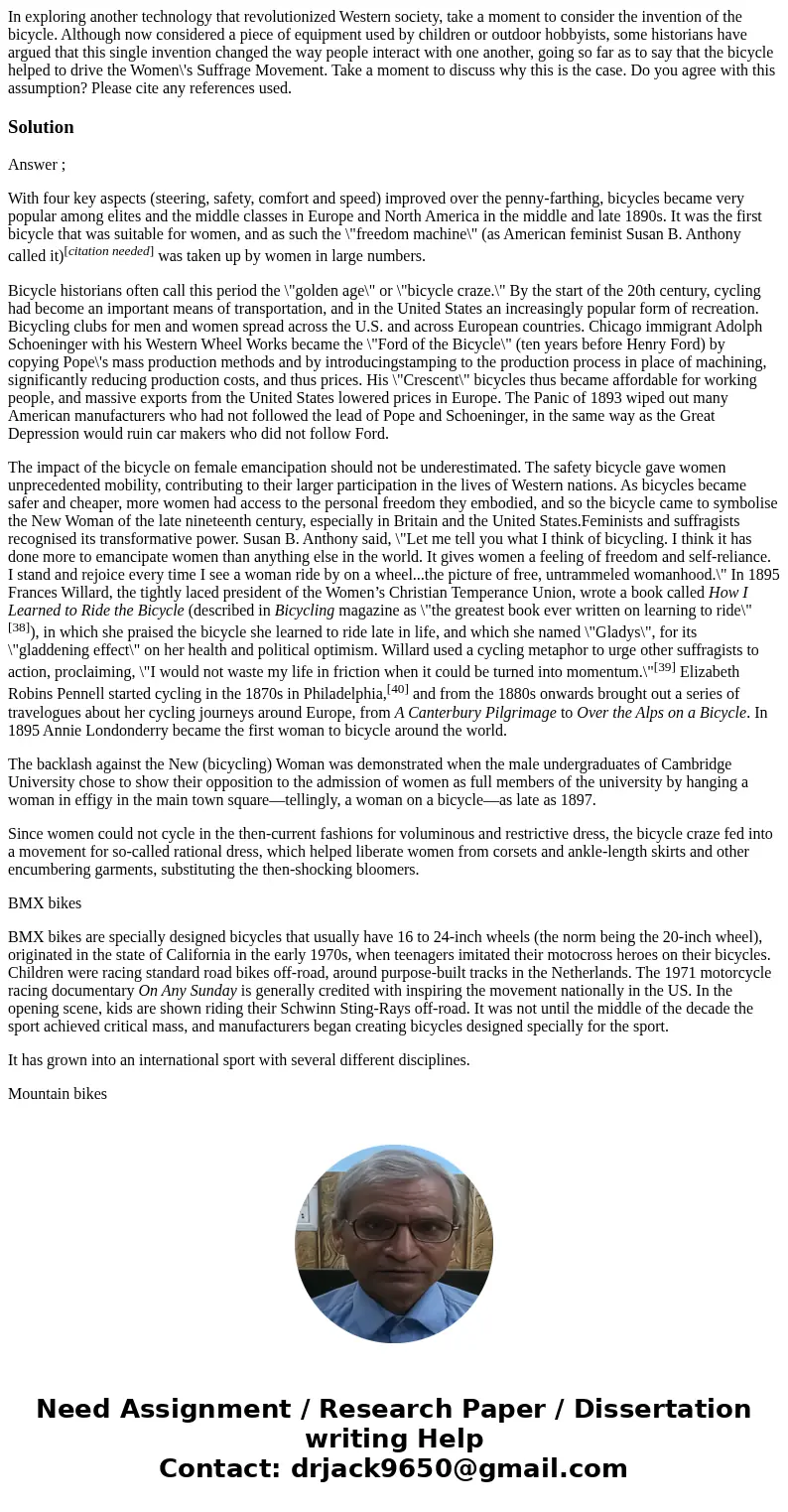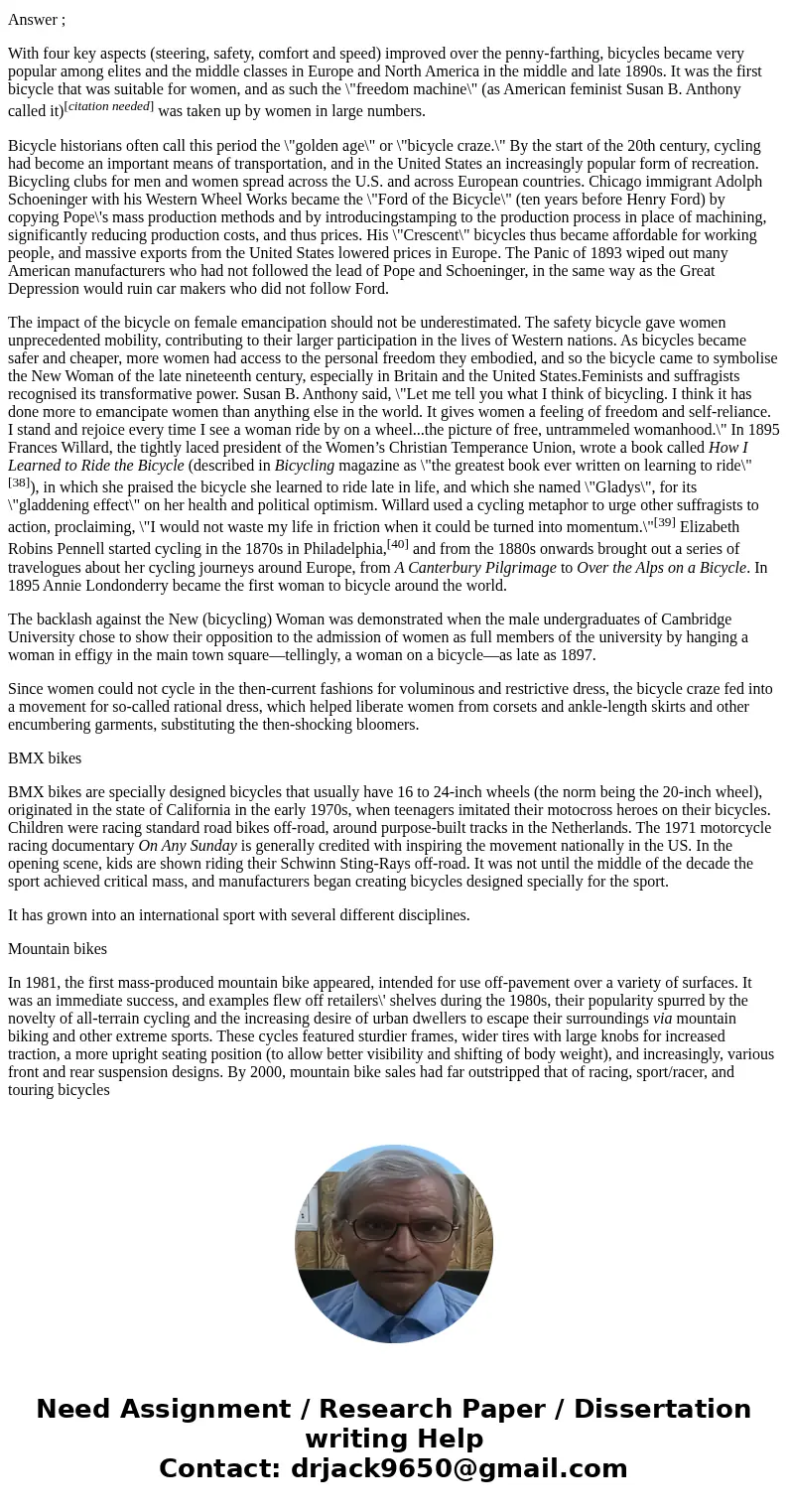In exploring another technology that revolutionized Western
In exploring another technology that revolutionized Western society, take a moment to consider the invention of the bicycle. Although now considered a piece of equipment used by children or outdoor hobbyists, some historians have argued that this single invention changed the way people interact with one another, going so far as to say that the bicycle helped to drive the Women\'s Suffrage Movement. Take a moment to discuss why this is the case. Do you agree with this assumption? Please cite any references used.
Solution
Answer ;
With four key aspects (steering, safety, comfort and speed) improved over the penny-farthing, bicycles became very popular among elites and the middle classes in Europe and North America in the middle and late 1890s. It was the first bicycle that was suitable for women, and as such the \"freedom machine\" (as American feminist Susan B. Anthony called it)[citation needed] was taken up by women in large numbers.
Bicycle historians often call this period the \"golden age\" or \"bicycle craze.\" By the start of the 20th century, cycling had become an important means of transportation, and in the United States an increasingly popular form of recreation. Bicycling clubs for men and women spread across the U.S. and across European countries. Chicago immigrant Adolph Schoeninger with his Western Wheel Works became the \"Ford of the Bicycle\" (ten years before Henry Ford) by copying Pope\'s mass production methods and by introducingstamping to the production process in place of machining, significantly reducing production costs, and thus prices. His \"Crescent\" bicycles thus became affordable for working people, and massive exports from the United States lowered prices in Europe. The Panic of 1893 wiped out many American manufacturers who had not followed the lead of Pope and Schoeninger, in the same way as the Great Depression would ruin car makers who did not follow Ford.
The impact of the bicycle on female emancipation should not be underestimated. The safety bicycle gave women unprecedented mobility, contributing to their larger participation in the lives of Western nations. As bicycles became safer and cheaper, more women had access to the personal freedom they embodied, and so the bicycle came to symbolise the New Woman of the late nineteenth century, especially in Britain and the United States.Feminists and suffragists recognised its transformative power. Susan B. Anthony said, \"Let me tell you what I think of bicycling. I think it has done more to emancipate women than anything else in the world. It gives women a feeling of freedom and self-reliance. I stand and rejoice every time I see a woman ride by on a wheel...the picture of free, untrammeled womanhood.\" In 1895 Frances Willard, the tightly laced president of the Women’s Christian Temperance Union, wrote a book called How I Learned to Ride the Bicycle (described in Bicycling magazine as \"the greatest book ever written on learning to ride\"[38]), in which she praised the bicycle she learned to ride late in life, and which she named \"Gladys\", for its \"gladdening effect\" on her health and political optimism. Willard used a cycling metaphor to urge other suffragists to action, proclaiming, \"I would not waste my life in friction when it could be turned into momentum.\"[39] Elizabeth Robins Pennell started cycling in the 1870s in Philadelphia,[40] and from the 1880s onwards brought out a series of travelogues about her cycling journeys around Europe, from A Canterbury Pilgrimage to Over the Alps on a Bicycle. In 1895 Annie Londonderry became the first woman to bicycle around the world.
The backlash against the New (bicycling) Woman was demonstrated when the male undergraduates of Cambridge University chose to show their opposition to the admission of women as full members of the university by hanging a woman in effigy in the main town square—tellingly, a woman on a bicycle—as late as 1897.
Since women could not cycle in the then-current fashions for voluminous and restrictive dress, the bicycle craze fed into a movement for so-called rational dress, which helped liberate women from corsets and ankle-length skirts and other encumbering garments, substituting the then-shocking bloomers.
BMX bikes
BMX bikes are specially designed bicycles that usually have 16 to 24-inch wheels (the norm being the 20-inch wheel), originated in the state of California in the early 1970s, when teenagers imitated their motocross heroes on their bicycles. Children were racing standard road bikes off-road, around purpose-built tracks in the Netherlands. The 1971 motorcycle racing documentary On Any Sunday is generally credited with inspiring the movement nationally in the US. In the opening scene, kids are shown riding their Schwinn Sting-Rays off-road. It was not until the middle of the decade the sport achieved critical mass, and manufacturers began creating bicycles designed specially for the sport.
It has grown into an international sport with several different disciplines.
Mountain bikes
In 1981, the first mass-produced mountain bike appeared, intended for use off-pavement over a variety of surfaces. It was an immediate success, and examples flew off retailers\' shelves during the 1980s, their popularity spurred by the novelty of all-terrain cycling and the increasing desire of urban dwellers to escape their surroundings via mountain biking and other extreme sports. These cycles featured sturdier frames, wider tires with large knobs for increased traction, a more upright seating position (to allow better visibility and shifting of body weight), and increasingly, various front and rear suspension designs. By 2000, mountain bike sales had far outstripped that of racing, sport/racer, and touring bicycles


 Homework Sourse
Homework Sourse